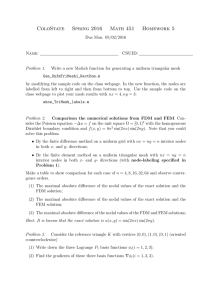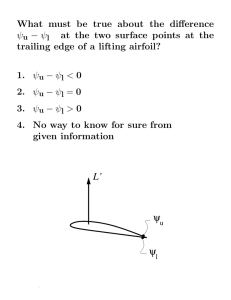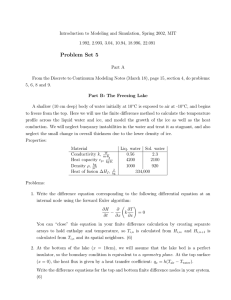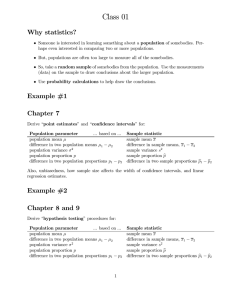Document 13568149
advertisement
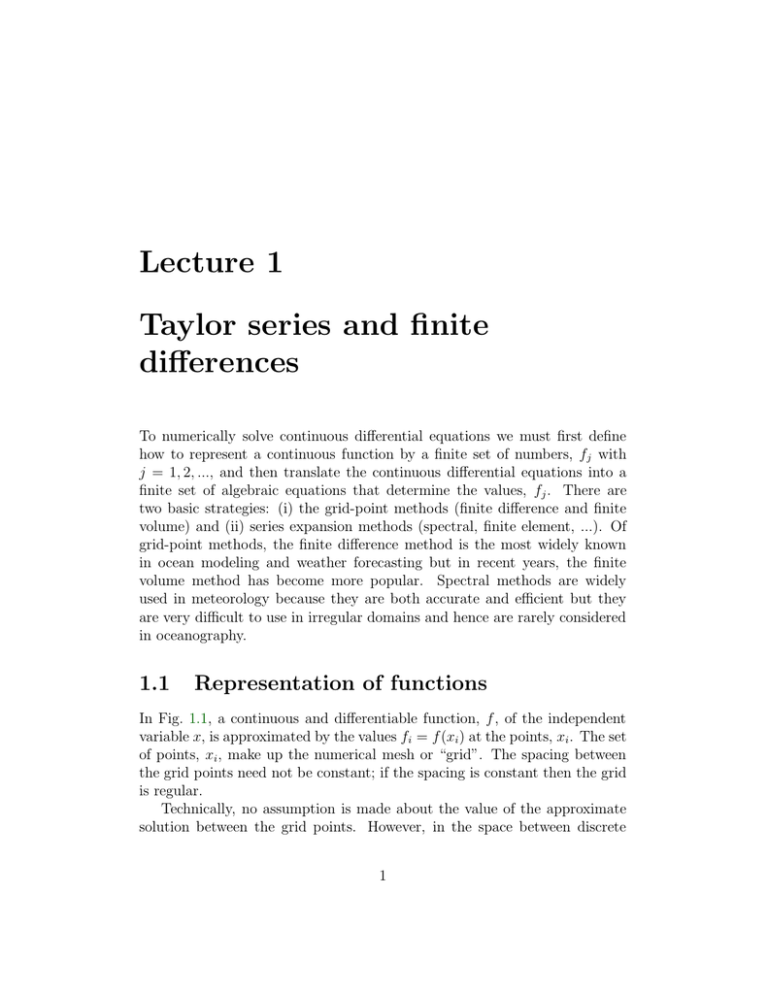
Lecture 1
Taylor series and finite
differences
To numerically solve continuous differential equations we must first define
how to represent a continuous function by a finite set of numbers, fj with
j = 1, 2, ..., and then translate the continuous differential equations into a
finite set of algebraic equations that determine the values, fj . There are
two basic strategies: (i) the grid-point methods (finite difference and finite
volume) and (ii) series expansion methods (spectral, finite element, ...). Of
grid-point methods, the finite difference method is the most widely known
in ocean modeling and weather forecasting but in recent years, the finite
volume method has become more popular. Spectral methods are widely
used in meteorology because they are both accurate and efficient but they
are very difficult to use in irregular domains and hence are rarely considered
in oceanography.
1.1
Representation of functions
In Fig. 1.1, a continuous and differentiable function, f , of the independent
variable x, is approximated by the values fi = f (xi ) at the points, xi . The set
of points, xi , make up the numerical mesh or “grid”. The spacing between
the grid points need not be constant; if the spacing is constant then the grid
is regular.
Technically, no assumption is made about the value of the approximate
solution between the grid points. However, in the space between discrete
1
2
12.950 Atmospheric and Oceanic Modeling, Spring ’04
f(x)
fi+1
fi
fi−1
x
xi−1
xi
xi+1
Figure 1.1: An approximation to a smooth and continuous function, f (x),
can be represented by the truncated set of values {fi−1 , fi , . . .} evaluated at
the grid points {xi−1 , xi , . . .} where fi � f (xi ).
grid points, for example xi−1 < x� < xi , the function can be interpolated
assuming a particular representation of the function based on the known
values fi−1 , fi , . . .. For example, Fig. 1.2 shows a straight line drawn between
values fi−1 and fi which is given by
x� − xi−1
f˜(x� ) = (1−�(x� ))fi−1 +�(x� )fi where �(x) �
xi − xi−1
≤xi−1 � x� � xi
(1.1)
�
˜
so that f (x ) is the approximation to f (x). This is “linear interpolation”.
Higher order interpolation and other representations (such as quadratic,
spline or high order polynomial) are possible.
1.2
Taylor series and truncation error
Taylor series can be used to estimate a truncation error in an approximation
of a function and also used to establish approximations to derivatives. The
Taylor series expansion at a point x is
f (x ± β) = f (x) +
�
�
j=1
βj
(±1)j � j
f
j! �xj
3
12.950 Atmospheric and Oceanic Modeling, Spring ’04
f(x)
Δx
Δx1
Δx2
fi
f(x’)
fi−1
x
xi−1 x’
xi
Figure 1.2: Linear interpolation (dashed line) between values fi of a function
f (x) (thin line) on a discrete grid xi .
= f (x) ± βf � (x) +
β2 ��
β3
β4
f (x) ± f ��� (x) + f ���� (x) + . . .
2!
3!
4!
where β is some small displacement from x.
To estimate the error incurred evaluating the function f (x) using linear
interpolation (equation 1.1) we can replace the values fi−1 and fi with Taylor
series expansions about the point of evaluation, x:
�x21 ��
f (x) − . . .
2!
�x22 ��
fi = f (x + �x2 ) = f (x) + �x2 f � (x) +
f (x) + . . . .
2!
fi−1 = f (x − �x1 ) = f (x) − �x1 f � (x) +
where
�x1 � x − xi−1 and �x2 � xi − x.
Substituting into (1.1) gives
�x2
f (x) − �x1 f � (x) +
�x1 + �x2
⎠
�x1
+
f (x) + �x2 f � (x) +
�x1 + �x2
1
= f (x) + �x1 �x2 f �� (x) + . . . .
2
f˜(x) =
⎠
1 2 ��
�x f (x) − . . .
2 1
�
1 2 ��
�x f (x) + . . .
2 2
�
12.950 Atmospheric and Oceanic Modeling, Spring ’04
4
This allows us to estimate the error f˜(x) − f (x) as
1
1
f˜(x) − f (x) � �x1 (�x − �x1 )f �� (x) = �x2 �(1 − �)f �� (x)
(1.2)
2
2
dropping higher order terms. Here �x = xi − xi−1 = �x1 + �x2 is the grid
spacing and
�x1
�x1
� =
=
�x
�x1 + �x2
is the non-dimensional position within the space interval (0 � � � 1). Note
some properties about the estimate of error for linear interpolation:
• the error scales with the square of the grid spacing (�x2 ),
• the error is reduced if the interpolation point is near the ends of the
interval (� 2 ≡ 0, 1). i.e. near a data value,
• the error is largest in the middle of the interval (� ≡ 21 ), equidistant
from the data values.
The order of accuracy of an approximation refers to the scaling with
mesh parameters (normally the grid resolution). The above analysis tells
us that linear interpolation is second order accurate or that errors are of
order O(�x2 ). This means that doubling the resolution (i.e. halving the
grid spacing) reduces the error by a factor of four.
1.3 Constructing difference operators using
Taylor series
Finite differencing is the method of approximating partial derivatives with
differences between function values (on a grid). The Taylor series for fi−1 (x), fi (x), ...
can be re-arranged to yield expressions for the derivatives, f � (x), f �� (x), ...
yielding formula for approximating derivatives with discrete differences and
truncation error.
As an example, consider how to estimate the first derivative, f � , at xi in
terms of fi−1 and fi . The Taylor series for fi−1 and fi expanded about xi
are:
�x2 ��
fi−1 = f (xi ) − �xf � (xi ) +
f (xi ) − . . .
2!
fi = f (xi )
5
12.950 Atmospheric and Oceanic Modeling, Spring ’04
where �x = xi − xi−1 is the grid spacing. Solving for f � (xi ) gives:
f � (xi ) �
1
�x ��
(fi − fi−1 ) +
f (xi )
�x
2
(1.3)
where we have dropped higher order terms. The difference formula (1.3) is
known as a side difference and is first order accurate, i.e. the truncation
error is of order O(�x). This is the simplest and least accurate of the finite
difference approximations but will appear in latter discussions about the
discretization of advection terms.
Now, consider the same data points but this time evaluate the derivative
at the mid-point, x¯ = 12 (xi−1 + xi ). The Taylor series are:
�x �
f (¯
x)
2
⎞
⎟
1 �x 2 ��
+
f (x̄) −
2! 2
�x �
= f (¯
x) +
f (¯
x)
2
⎞
⎟
1 �x 2 ��
f (x̄) +
+
2! 2
fi−1 = f (¯
x) −
fi
1 �x
3! 2
⎞
⎟3
f ��� (¯
x) +
1 �x
4! 2
⎞
⎟4
f ���� (¯
x) − . . .
1 �x
3! 2
⎟3
f ��� (¯
x) +
1 �x
4! 2
⎟4
f ���� (¯
x) + . . .
⎞
⎞
Solving for f � (x̄) gives:
f � (x̄) �
1
�x2 ���
(fi − fi−1 ) −
f (¯
x)
�x
4 · 3!
(1.4)
This is a centered difference and is second order accurate because the trun­
cation error is of order O(�x2 ). Because the evaluation point is at the
mid-point between grid nodes, the derivative is said to be staggered in space.
Comparing the formula (1.3) and (1.4), we see that the difference operator
is the same in each but the point at which the derivative is being approxi­
mated matters. Although the centered difference is formally of higher order
the truncation terms can not be directly compared since f �� (xi ) and f ��� (x̄)
are different and not known.
As a rule, centered evaluation of difference formula are more accurate
than off-center or side differences. Further, centered differences are generally
of even order and side differences typically of odd order, though it is possible
to construct even order side differences by placing the all points of the stencil
to one side of the evaluation point.
6
12.950 Atmospheric and Oceanic Modeling, Spring ’04
Finally, consider a centered difference evaluated at a grid point (rather
than a mid-point). Limiting ourselves to a uniform grid (i.e. xi+1 − xi =
xi − xi−1 = �x) we can construct the operator by applying the formula (1.4)
over a 2�x interval, yielding:
f � (xi ) �
�x2 ���
1
(fi+1 − fi−1 ) −
f (xi )
2�x
3!
(1.5)
This is also of second order accuracy but here the coefficient in the truncation
error is 4 times larger than for the staggered center difference. Therefore,
although we can not directly compare f ��� (xi ) with f ��� (x̄) because they are at
different locations, we can infer that the staggered difference is more accurate
than the 2�x difference when the variations in the function are well resolved.
1.3.1
Second derivative
To find a formula for the second derivative, f �� , we must use a stencil of at
least 3 points. Here, we’ll consider a uniform grid with spacing �x. The
Taylor series expanded about xi are:
fi−1 = f (xi ) − �xf � (xi ) +
�x2 ��
�x3 ���
�x4 ����
f (xi ) +
f (xi ) −
f (xi ) − . . .
2!
3!
4!
fi = f (xi )
fi+1 = f (xi ) + �xf � (xi ) +
�x2 ��
�x3 ���
�x4 ����
f (xi ) +
f (xi ) +
f (xi ) + . . .
2!
3!
4!
Solving for f �� (xi ) gives:
fi+1 − 2fi + fi−1 2�x2 ����
f (xi )
f (xi ) �
−
�x2
4!
��
(1.6)
dropping higher order terms.
1.3.2
Generating higher order differences
The process of finding difference formula and truncation terms has involves
several expansions of the Taylor series about the same point and then solving
the resulting simultaneous equations for the unknown derivatives. This can
be cast as a linear algebra problem and where we use Gaussian elimination
to solve for the derivatives.
7
12.950 Atmospheric and Oceanic Modeling, Spring ’04
The three Taylor series used in section 1.3.1 can be written as a matrix
problem:
�x2
2
�
1 −�x
�
0
� 1
1 �x
− �x
3!
0
0
3
�x4
4!
0
�x3
3!
�x2
2
�
⎛�
�
⎜�
⎝�
�
�
�
�x4
4!
f (xi )
f � (xi )
f �� (xi )
f ��� (xi )
f ���� (xi )
⎛
⎜
⎜
⎜
⎜
⎜
⎜
⎝
�
⎛
fi−1
�
= � fi ⎜
⎝
fi+1
where the vertical line indicates a square sub-matrix. If we multiply through
by the inverse of this sub-matrix then we get:
1 0 0
�
� 0 1 0
0 0 1
�
0
�
f (xi )
f � (xi )
f �� (xi )
f ��� (xi )
f ���� (xi )
�
0
�
⎜�
0 ⎝�
�
⎛
�x2
6
�x2
0
�
�
12
⎛
⎜
⎜
⎜
⎜
⎜
⎜
⎝
�
=�
�
0
−1
�x
1
�x2
1
0
−2
�x2
0
1
�x
1
�x2
⎛�
⎛
fi−1
⎜
⎜�
⎝ � fi ⎝
fi+1
This approach is identical to the derivations used in previous sections but in
just one operation yields all the difference approximations of derivatives up
to the order of the number of points.
Using five points, centered at xi , the result is:
�
�
�
�
�
�
�
�
�
1
0
0
0
0
0
1
0
0
0
0
0
1
0
0
0
0
0
1
0
�
=
�
�
�
�
�
�
�
0
0
0
0
0
1
⎛
0
0
−�x4
30
−�x4
90
0
�x2
4
0
�x2
6
0
0
0
1
12�x
−1
12�x2
−1
2�x3
1
12�x4
−2
3�x
4
3�x2
1
�x3
−4
�x4
�
�
�
⎜�
⎜�
⎜�
⎜�
⎜�
⎜�
⎜�
⎝�
�
�
1
0
−5
2�x2
0
6
�x4
f (xi )
f�
f ��
f ���
f ����
f �����
f ������
0
2
3�x
4
3�x2
−1
�x3
−4
�x4
⎛
⎜
⎜
⎜
⎜
⎜
⎜
⎜
⎜
⎜
⎜
⎜
⎝
0
−1
12�x
−1
12�x2
1
2�x3
1
�x4
⎛�
⎜�
⎜�
⎜�
⎜�
⎜�
⎜�
⎝�
fi−2
fi−1
fi
fi+1
fi+2
⎛
⎜
⎜
⎜
⎜
⎜
⎜
⎝
This gives us fourth order accurate formula for f � (x) and f �� (x) and second
order accurate formula for f ��� (x) and f ���� (x).
12.950 Atmospheric and Oceanic Modeling, Spring ’04
1.4
8
The size of truncation errors
It is worth bearing in mind that implicit in deriving the above formula is the
assumption that the truncation errors are small. We can formalize this by
non-dimensionalizing the problem. Consider the staggered difference given
by equation (1.4). If variations in f (x) are of order F and have length scale
L then we can non-dimensionalize (1.4):
�
F �� �
F � �
F �x� 2 ���� �
�
f (¯
x )�
f
−
f
−
f (¯
x )
i−1
L
L�x� i
4 · 3!L
or
�
�x� 2 ���� �
1 � �
�
−
−
f
f
x )
f (¯
i−1
�x� i
4 · 3!
where �x� = �x/L is a non-dimensional resolution parameter. The actual
error, normalized, is:
1
(fi − fi−1 )
βa = �x �
−1
f (x)
f �� (¯
x� ) �
and an estimate of the error can be based on the non-dimensional truncation
term:
�
�⎛
�
1
�
�
⎞
⎟
f
−
f
�x 2
1
i
i−1
�x
⎝−1≡
βe = O �
f � � (x� )
4 · 3! L
Example: Using the function f (x) = ex , we can verify that the actual
error converges with the right power as �x ≈ 0 and that the estimate of
error reflects the actual error. By substituting the continuous solution into
the difference approximation we can calculate the actual error, which is:
βa =
1 �x/2
(e
− e−�x/2 ) − 1
�x
while the estimate of the error, based on the the truncation terms is:
βe =
�x2
24
These errors are plotted in Fig. 1.3 and shows that the estimate is represen­
tative of actual errors for all reasonable �x (i.e. �x < 1).
9
12.950 Atmospheric and Oceanic Modeling, Spring ’04
2
10
x/L
ε : f(x)=e
a
ε : f(x)=sin(x/L)
a
ε =(Δx/L)2/24
1
10
e
0
Normalized error (ε)
10
−1
10
−2
10
−3
10
−4
10
−1
10
0
10
Δx/L
1
10
Figure 1.3: Actual and estimated errors for centered finite difference approx­
imation applied to the functions ex/L and sin x/L. For small �x, all curves
have a slope of −2. Note, also, that the estimate of error, βe , is reasonable
even up to �x ≡ 1.
10
12.950 Atmospheric and Oceanic Modeling, Spring ’04
Example: The same analysis can be made for the function f (x) = sin x/L.
The actual error, in this case, is:
βa =
2L
�x
sin
−1
�x
2L
and is also plotted in Fig. 1.3.
1.5
Stommel model in 1-D
We can illustrate the process of discretization and analysis with a simple one
dimensional version of the Stommel model. We will return to the Stommel
model at a later stage and explain where and what it is. The equation to be
solved, written in non-dimensional form, is:
β�xx γ + �x γ = −1
(1.7)
with boundary conditions γ(x = 0) = 0 and γ(x = 1) = 0. Here, β is a nondimensional friction which determines a boundary layer width. An analytic
solution to (1.7) exists which is:
�
x
�
γ = C e− � − 1 − x
with
1
C −1 = e− � − 1.
The existence of an analytic solution allows us to compare the estimated ac­
curacy of the discrete equations with the true error of the numerical solution.
We will find approximate numerical solutions to (1.7) on a regular grid of
N + 1 points, xi = �x(i − 1) where �x = 1/N using second order differences.
The second order approximations to the first and second derivatives of a
function are given by (1.5) and (1.6).
Substituting into (1.7) we obtain the following discrete system of N + 1
simultaneous algebraic equations:
β
1
(γi−1 − 2γi + γi+1 ) +
(−γi−1 + γi+1 ) = −1
2
�x
2�x
γi = 0
This can be posed as a linear algebra problem:
Aγ=b
≤ i = 2...N
≤ i = 1, N + 1.
11
12.950 Atmospheric and Oceanic Modeling, Spring ’04
where A is a tri-diagonal (sparse) matrix given by:
Ai,i−1 =
Ai,i =
Ai,i+1 =
A1,1 =
AN +1,N +1 =
β
1
−
2
�x
�x
−2β
�x2
β
1
+
2
�x
�x
1
1
≤ i = 2...N
The tri-diagonal structure of A means it can be solved “directly” using, for
example, LU decomposition or cyclic reduction.
Any row of the matrix between i = 2 and i = N corresponds to the stencil
of the difference equation;
⎠
1
β
−
2
�x
2�x
−2β
�x2
1
β
+
2
�x
2�x
�
Note that for large β, the signs of the elements of the stencil are [1 − 1 1]
and that at a critical value of β = �x/2 the sign of the western most point
changes (to the left at i − 1) i.e. the stencil has signs [−1 − 1 1]. When
this happens, the equations are no longer elliptic (the hyperbolic term dom­
inates everywhere) and some of the eigenvalues have imaginary components.
Physically, this change in behavior occurs when the boundary is on the verge
of being resolved. When under resolved, the imaginary components of the
eigenvalues lead to oscillations in the solution.
Numerical and analytic solutions are plotted in Fig. 1.4. For the well re­
solved case, the two curves are barely indistinguishable, but as the resolution
is reduced, significant differences (errors) appear in the boundary layer. In
the under-resolved case, oscillations emanate from the boundary layer and
reach into the interior. Clearly,
If we were more concerned with obtaining a solution that was “robust”,
meaning that it’s properties are not critically dependent on numerical pa­
rameters, then we could use first order differencing for the beta term. In this
case, the stencil is:
⎠
β
�x2
−2β
1
−
2
�x
2�x
β
1
+
2
�x
�x
�
12.950 Atmospheric and Oceanic Modeling, Spring ’04
12
Note, the the first order difference is “up-wind” in the sense of westward
propagating characteristics. Here, the signs of the stencil elements are inde­
pendent of the numerical parameters and we can then expect the eigenvalues
of the problem to remain real also. Numerical solutions are also plotted in
Fig. 1.4 and here the solutions all look “physical” (i.e. no non-physical os­
cillations) for all resolutions. However, the convergence properties are poor,
formerly of first order and so even when the western boundary layer is well
resolved, the solution is visibly inaccurate in the vicinity of the boundary.
1.5.1
Measures of error
In this particular example, we can measure the error formally since we have
an analytical solution. Williamson, 1992, defined a set of “normalized global
errors” for use in evaluating global meteorological models. In this context,
they are:
l1 (γ) =
I(|γ − γT |)
I(|γT |)
(1.8)
1
l2 (γ) =
I(|γ − γT |2 ) 2
1
I(|γT |2 ) 2
max(|γ − γT |)
l� (γ) =
max(|γT |)
(1.9)
(1.10)
where I(γ) = 01 γ dx and γT is the true solution. The normalized errors for
the numerical solutions to the Stommel model are plotted as a function of
resolution in Fig. 1.5. The slope confirms that the solutions converge with
second and first order accuracy respectively for the centered and upwind
schemes. Note that the convergence behaviour is non-trivial at very low
resolutions and that in terms of these absolute measures, the first order
scheme can appear more accurate than the second order scheme.
�
1.6
Common notation and stencils
Writing out the algebraic equations using subscripts resulting from differ­
enced model equations can be a tedious and very lengthy process. A no­
tation, used widely since Arakawa and Lamb, 1968, greatly simplifies the
process.
13
12.950 Atmospheric and Oceanic Modeling, Spring ’04
There are two basic operators, the (staggered) center difference and the
average or center linear interpolation. We define the operators as follows:
αi f = fi+ 1 − fi− 1
2
2
1
i
(f 1 + fi− 1 )
f =
2
2
i+ 2
(1.11)
(1.12)
These operators satisfy the following rules:
1. The difference and average operators commute:
αi αj f = α j αi f
αi f
f
i
j
= αi
j
= f
(1.13)
j
j
(1.14)
i
(1.15)
2. Differencing products obeys a discrete analog of the product rule:
i
αi (f g) = f αi g + g i αi f
i
αi (f g) = f αi g + gαi f
i
(1.16)
(1.17)
3. Averaging products obeys a sum of squares rule:
fg
i
fg
i
i
1
i
= f g i + (αi f )(αi g)
4
1
i
= f g + αi (gαi f )
4
(1.18)
(1.19)
These relations and the notation greatly simplify some analysis. For
example, to prove that a particular discretization of advection conserves the
volume integral of the second moment (< ψu�x ψ >= 0):
ψuαi ψ
i
i
1
i
= ψ uαi ψ − αi (u(αi ψ)(αi ψ))
4
i
2
ψ
u
= uαi
− αi ( (αi ψ)2 )
2
4
All the centered difference approximations can be constructed from the
difference and average operators. For example, the staggered center difference
is:
fi+ 1 − fi− 1
1
2
2
f� �
=
αi f
�x
�x
12.950 Atmospheric and Oceanic Modeling, Spring ’04
14
The 2�x difference is:
fi+1 − fi−1
1
i
=
αi f
2�x
�x
The second order, second derivative is:
f� �
fi+1 − 2fi + fi−1
1
=
αi αi f
�x2
�x2
It is sometimes useful to describe the “stencil”, being the pattern of con­
nections in a difference equation or operator. In these notes, we will use
square brackets to indicate stencil notation. For example, the second order
difference
fi+1 − fi−1
i
αi f =
2�x
has a two point stencil, which using our short-hand is
f �� �
1
[−1 0 1]
2�x
and the fourth order difference
1
2
2
1
fi−1 +
fi+1 −
fi+2
f� �
fi−2 −
12�x
3�x
3�x
12�x
has the five point stencil
1
[1 − 8 0 8 − 1]
12�x
We can de-compose this stencil into the difference of two stencils:
[1 − 8 0 8 − 1] = [1 − 8 1 0 0] − [0 0 1 − 8 1]
and each of these can be de-composed further:
[1 − 8 1] = −[0 6 0] + [1 − 2 1].
This tells us that the fourth order finite difference can be written succinctly
as:
i
1
1
�
f �
αi (f − αii f ) .
�x
6
2
Note that the second term is a discrete approximation of �6x f ��� which is
the truncation term of the second order finite difference. In other words,
higher order difference formula can be found by substituting a difference
approximation for the leading truncation terms in low order formula.
15
12.950 Atmospheric and Oceanic Modeling, Spring ’04
n=8
Δx/2ε=3.125
1
Analytical solution
Sub−sampled analytic soln
Numerical solution O(Δx2)
Numerical solution O(Δx)
0.8
Ψ
0.6
0.4
0.2
0
0
0.2
0.4
n=25
0.6
X
Δx/2ε=1
0.8
1
1
Analytical solution
Sub−sampled analytic soln
2
Numerical solution O(Δx )
Numerical solution O(Δx)
0.8
Ψ
0.6
0.4
0.2
0
0
0.2
0.4
n=50
0.6
X
Δx/2ε=0.5
0.8
1
1
Analytical solution
Sub−sampled analytic soln
2
Numerical solution O(Δx )
Numerical solution O(Δx)
0.8
Ψ
0.6
0.4
0.2
0
0
0.2
0.4
0.6
0.8
1
X
Figure 1.4: Solutions to the 1-D Stommel model for three resolutions: underresolved, critical and resolved. Plotted are the analytic solution, the analytic
solution sub-sampled onto the model grid and two numerical solutions, one
using second order (centered) differences and the other usign first order up­
wind difference of the ∂-term. The oscillations in the second order solution
(top panel) result from the appearance of imaginary eigenvalues in the ma­
trix problem. The first order solution is “robust” in that it never exhibits
oscillations but it converges more slowly than the second order solution.
16
12.950 Atmospheric and Oceanic Modeling, Spring ’04
0
10
1
Δx
−1
10
−2
Error
10
Δx2
−3
10
L Centered
∞
L Centered
2
L Centered
1
L∞ Upwind
L Upwind
2
L Upwind
1
−4
10
−5
10
−3
10
−2
10
−1
Δx
10
0
10
Figure 1.5: The convergence of the numerical solutions to the 1-D Stommel
model. The errors are the l1 , l2 and l� norms and are plotted for the centered
(×) and upwind (∀) differenced models for different resolutions. The slope
of the centered difference error curve is 2 which is consistent with the second
order accuracy of the discrete equations. Similarly the upwind differenced
error curves has a slope of 1 but note the tapering at low resolution.
